Business Law Assignment: Contract Law, Dispute Resolution Analysis
VerifiedAdded on 2021/04/24
|8
|1547
|21
Homework Assignment
AI Summary
This business law assignment analyzes a scenario involving a contract dispute between Andy and Cockatoo Educational Resources. The assignment explores the essentials of contract formation, including offer, acceptance, intention to create legal relations, and consideration. It examines whether a valid contract was formed and the impact of terms of advertisement and exclusion clauses. The assignment further investigates dispute resolution methods, such as negotiation, mediation, and arbitration, and identifies the most favorable approach for resolving the dispute. The document provides legal analysis, applying relevant case law and principles to the facts, and includes a reference list of cited cases and legal texts. This assignment is a comprehensive overview of contract law and dispute resolution within a business context, offering practical insights into legal principles and their application.
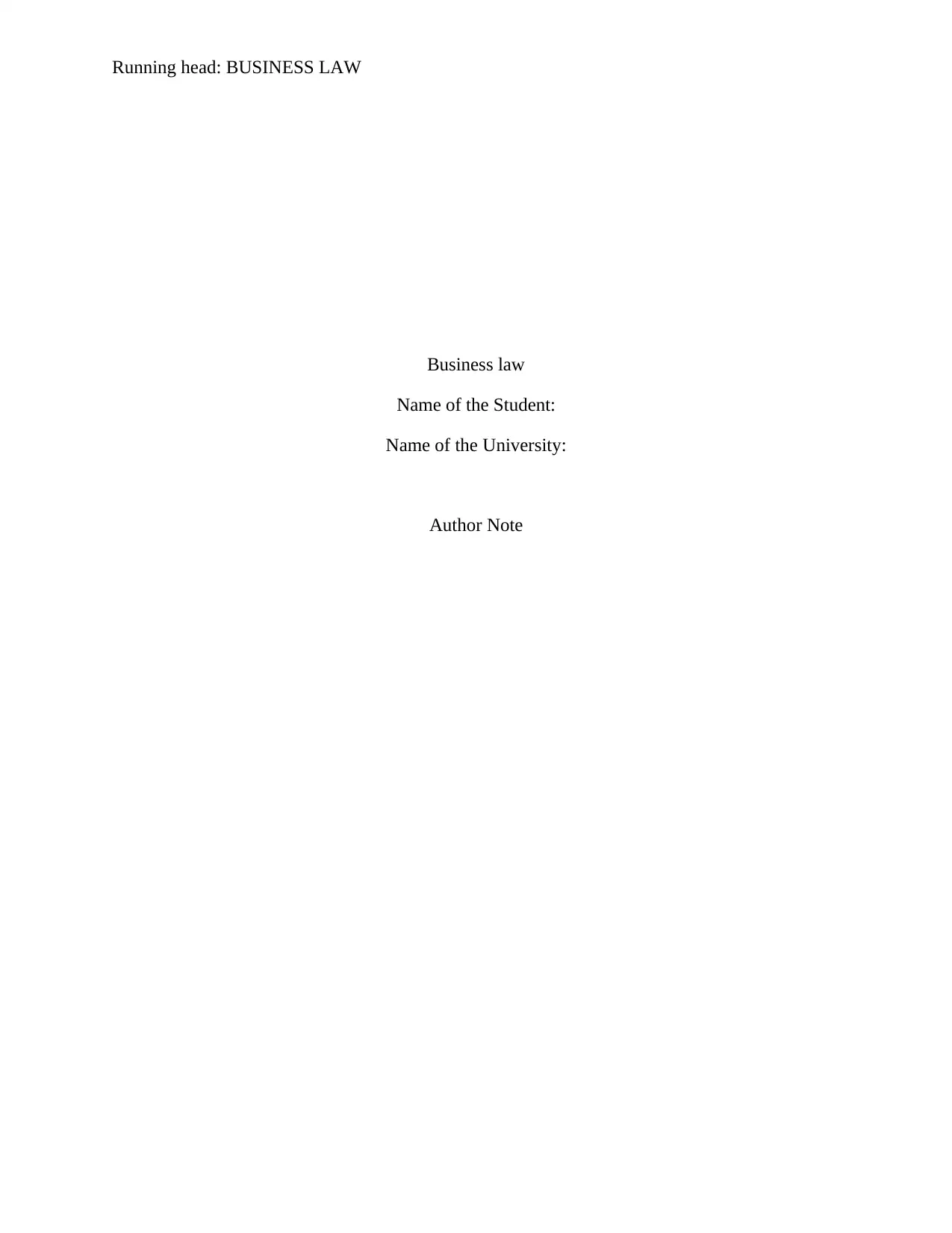
Running head: BUSINESS LAW
Business law
Name of the Student:
Name of the University:
Author Note
Business law
Name of the Student:
Name of the University:
Author Note
Paraphrase This Document
Need a fresh take? Get an instant paraphrase of this document with our AI Paraphraser
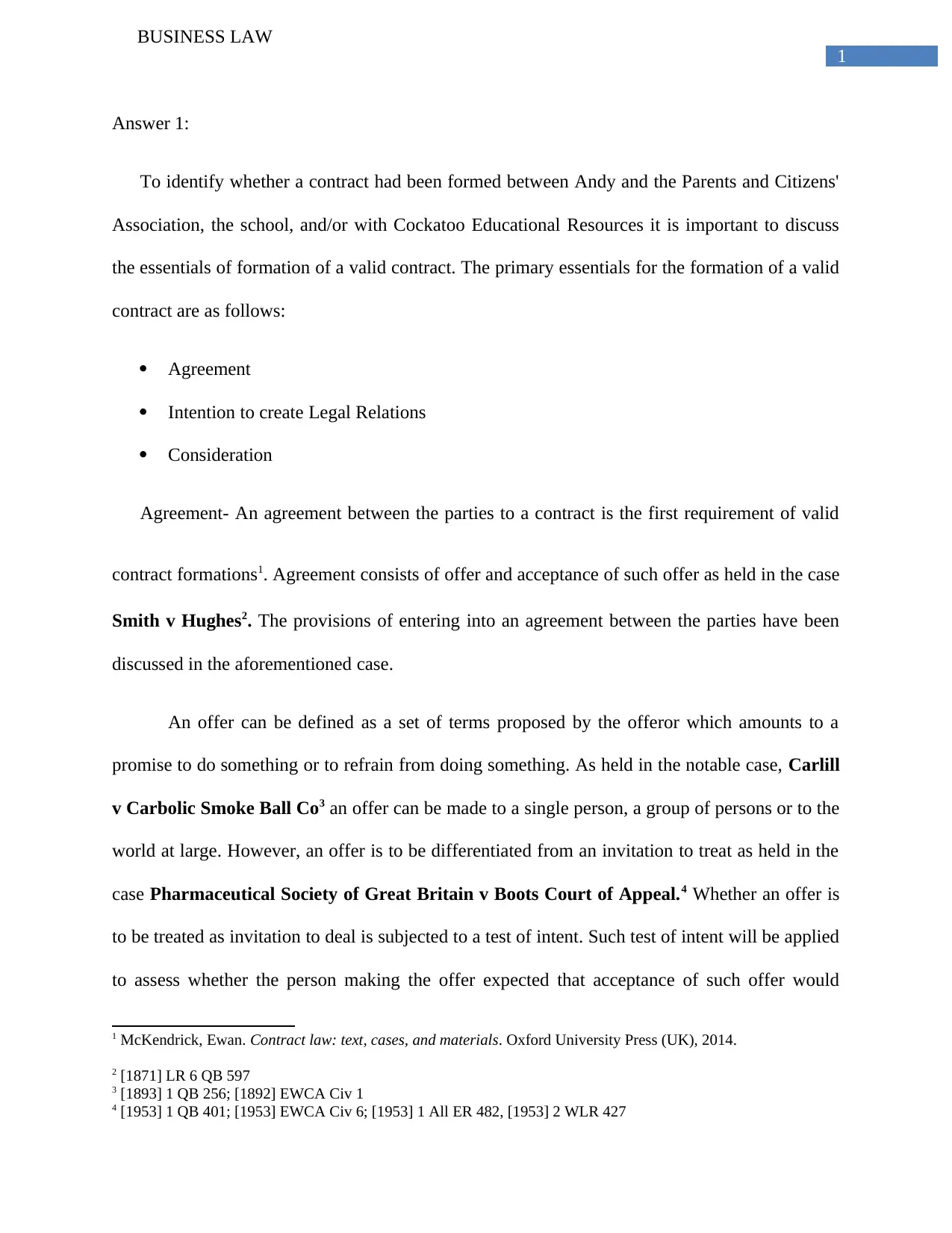
1
BUSINESS LAW
Answer 1:
To identify whether a contract had been formed between Andy and the Parents and Citizens'
Association, the school, and/or with Cockatoo Educational Resources it is important to discuss
the essentials of formation of a valid contract. The primary essentials for the formation of a valid
contract are as follows:
Agreement
Intention to create Legal Relations
Consideration
Agreement- An agreement between the parties to a contract is the first requirement of valid
contract formations1. Agreement consists of offer and acceptance of such offer as held in the case
Smith v Hughes2. The provisions of entering into an agreement between the parties have been
discussed in the aforementioned case.
An offer can be defined as a set of terms proposed by the offeror which amounts to a
promise to do something or to refrain from doing something. As held in the notable case, Carlill
v Carbolic Smoke Ball Co3 an offer can be made to a single person, a group of persons or to the
world at large. However, an offer is to be differentiated from an invitation to treat as held in the
case Pharmaceutical Society of Great Britain v Boots Court of Appeal.4 Whether an offer is
to be treated as invitation to deal is subjected to a test of intent. Such test of intent will be applied
to assess whether the person making the offer expected that acceptance of such offer would
1 McKendrick, Ewan. Contract law: text, cases, and materials. Oxford University Press (UK), 2014.
2 [1871] LR 6 QB 597
3 [1893] 1 QB 256; [1892] EWCA Civ 1
4 [1953] 1 QB 401; [1953] EWCA Civ 6; [1953] 1 All ER 482, [1953] 2 WLR 427
BUSINESS LAW
Answer 1:
To identify whether a contract had been formed between Andy and the Parents and Citizens'
Association, the school, and/or with Cockatoo Educational Resources it is important to discuss
the essentials of formation of a valid contract. The primary essentials for the formation of a valid
contract are as follows:
Agreement
Intention to create Legal Relations
Consideration
Agreement- An agreement between the parties to a contract is the first requirement of valid
contract formations1. Agreement consists of offer and acceptance of such offer as held in the case
Smith v Hughes2. The provisions of entering into an agreement between the parties have been
discussed in the aforementioned case.
An offer can be defined as a set of terms proposed by the offeror which amounts to a
promise to do something or to refrain from doing something. As held in the notable case, Carlill
v Carbolic Smoke Ball Co3 an offer can be made to a single person, a group of persons or to the
world at large. However, an offer is to be differentiated from an invitation to treat as held in the
case Pharmaceutical Society of Great Britain v Boots Court of Appeal.4 Whether an offer is
to be treated as invitation to deal is subjected to a test of intent. Such test of intent will be applied
to assess whether the person making the offer expected that acceptance of such offer would
1 McKendrick, Ewan. Contract law: text, cases, and materials. Oxford University Press (UK), 2014.
2 [1871] LR 6 QB 597
3 [1893] 1 QB 256; [1892] EWCA Civ 1
4 [1953] 1 QB 401; [1953] EWCA Civ 6; [1953] 1 All ER 482, [1953] 2 WLR 427
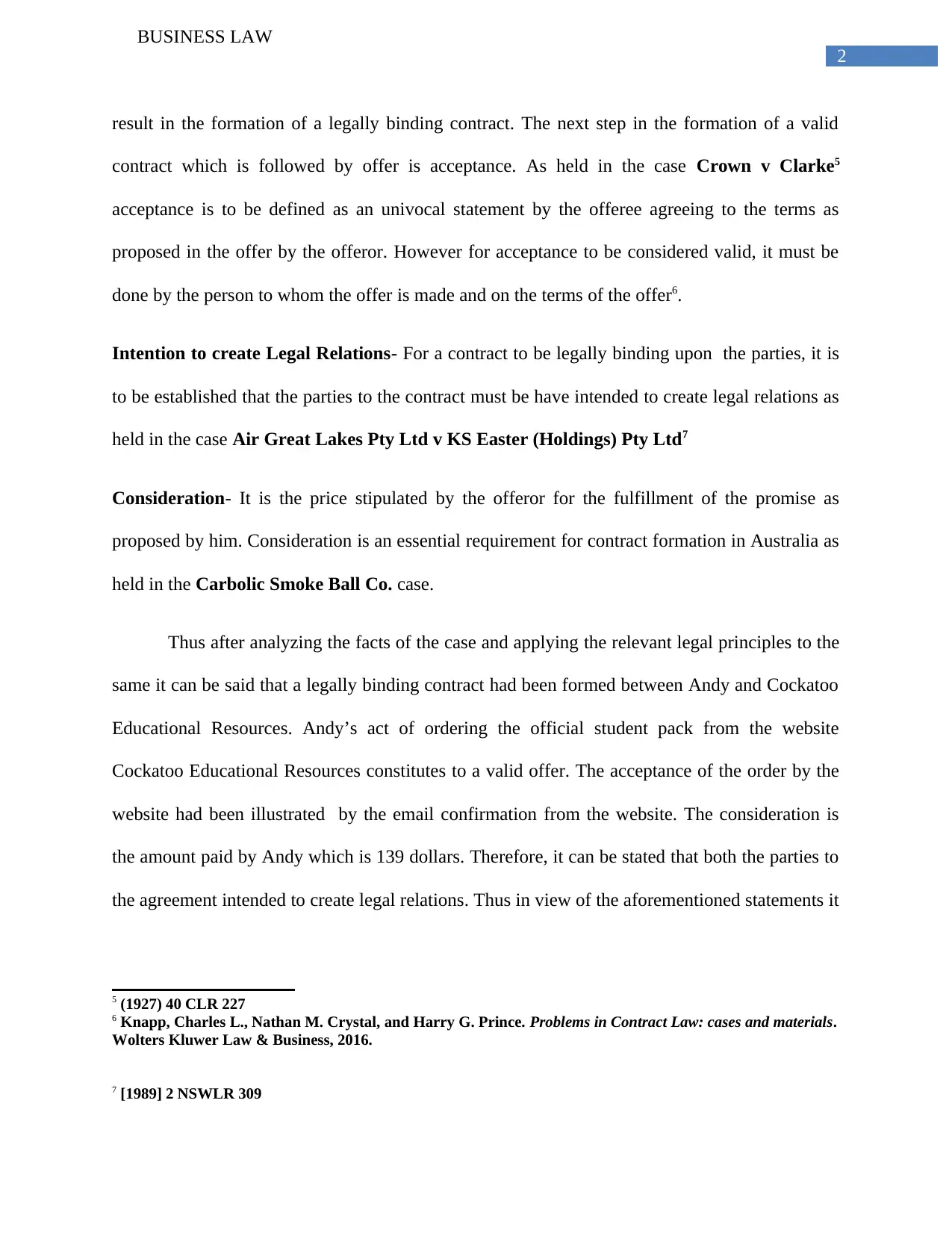
2
BUSINESS LAW
result in the formation of a legally binding contract. The next step in the formation of a valid
contract which is followed by offer is acceptance. As held in the case Crown v Clarke5
acceptance is to be defined as an univocal statement by the offeree agreeing to the terms as
proposed in the offer by the offeror. However for acceptance to be considered valid, it must be
done by the person to whom the offer is made and on the terms of the offer6.
Intention to create Legal Relations- For a contract to be legally binding upon the parties, it is
to be established that the parties to the contract must be have intended to create legal relations as
held in the case Air Great Lakes Pty Ltd v KS Easter (Holdings) Pty Ltd7
Consideration- It is the price stipulated by the offeror for the fulfillment of the promise as
proposed by him. Consideration is an essential requirement for contract formation in Australia as
held in the Carbolic Smoke Ball Co. case.
Thus after analyzing the facts of the case and applying the relevant legal principles to the
same it can be said that a legally binding contract had been formed between Andy and Cockatoo
Educational Resources. Andy’s act of ordering the official student pack from the website
Cockatoo Educational Resources constitutes to a valid offer. The acceptance of the order by the
website had been illustrated by the email confirmation from the website. The consideration is
the amount paid by Andy which is 139 dollars. Therefore, it can be stated that both the parties to
the agreement intended to create legal relations. Thus in view of the aforementioned statements it
5 (1927) 40 CLR 227
6 Knapp, Charles L., Nathan M. Crystal, and Harry G. Prince. Problems in Contract Law: cases and materials.
Wolters Kluwer Law & Business, 2016.
7 [1989] 2 NSWLR 309
BUSINESS LAW
result in the formation of a legally binding contract. The next step in the formation of a valid
contract which is followed by offer is acceptance. As held in the case Crown v Clarke5
acceptance is to be defined as an univocal statement by the offeree agreeing to the terms as
proposed in the offer by the offeror. However for acceptance to be considered valid, it must be
done by the person to whom the offer is made and on the terms of the offer6.
Intention to create Legal Relations- For a contract to be legally binding upon the parties, it is
to be established that the parties to the contract must be have intended to create legal relations as
held in the case Air Great Lakes Pty Ltd v KS Easter (Holdings) Pty Ltd7
Consideration- It is the price stipulated by the offeror for the fulfillment of the promise as
proposed by him. Consideration is an essential requirement for contract formation in Australia as
held in the Carbolic Smoke Ball Co. case.
Thus after analyzing the facts of the case and applying the relevant legal principles to the
same it can be said that a legally binding contract had been formed between Andy and Cockatoo
Educational Resources. Andy’s act of ordering the official student pack from the website
Cockatoo Educational Resources constitutes to a valid offer. The acceptance of the order by the
website had been illustrated by the email confirmation from the website. The consideration is
the amount paid by Andy which is 139 dollars. Therefore, it can be stated that both the parties to
the agreement intended to create legal relations. Thus in view of the aforementioned statements it
5 (1927) 40 CLR 227
6 Knapp, Charles L., Nathan M. Crystal, and Harry G. Prince. Problems in Contract Law: cases and materials.
Wolters Kluwer Law & Business, 2016.
7 [1989] 2 NSWLR 309
⊘ This is a preview!⊘
Do you want full access?
Subscribe today to unlock all pages.

Trusted by 1+ million students worldwide
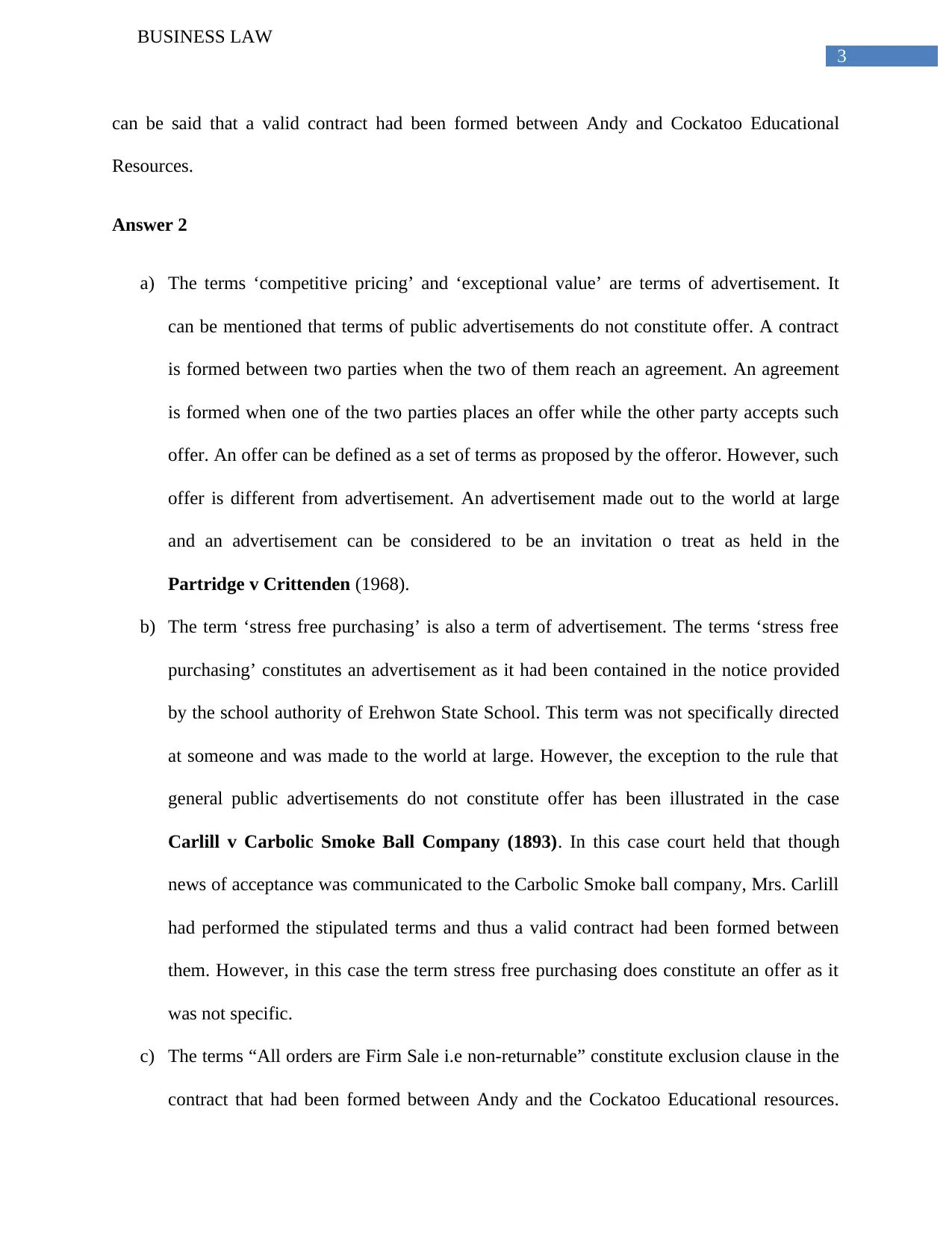
3
BUSINESS LAW
can be said that a valid contract had been formed between Andy and Cockatoo Educational
Resources.
Answer 2
a) The terms ‘competitive pricing’ and ‘exceptional value’ are terms of advertisement. It
can be mentioned that terms of public advertisements do not constitute offer. A contract
is formed between two parties when the two of them reach an agreement. An agreement
is formed when one of the two parties places an offer while the other party accepts such
offer. An offer can be defined as a set of terms as proposed by the offeror. However, such
offer is different from advertisement. An advertisement made out to the world at large
and an advertisement can be considered to be an invitation o treat as held in the
Partridge v Crittenden (1968).
b) The term ‘stress free purchasing’ is also a term of advertisement. The terms ‘stress free
purchasing’ constitutes an advertisement as it had been contained in the notice provided
by the school authority of Erehwon State School. This term was not specifically directed
at someone and was made to the world at large. However, the exception to the rule that
general public advertisements do not constitute offer has been illustrated in the case
Carlill v Carbolic Smoke Ball Company (1893). In this case court held that though
news of acceptance was communicated to the Carbolic Smoke ball company, Mrs. Carlill
had performed the stipulated terms and thus a valid contract had been formed between
them. However, in this case the term stress free purchasing does constitute an offer as it
was not specific.
c) The terms “All orders are Firm Sale i.e non-returnable” constitute exclusion clause in the
contract that had been formed between Andy and the Cockatoo Educational resources.
BUSINESS LAW
can be said that a valid contract had been formed between Andy and Cockatoo Educational
Resources.
Answer 2
a) The terms ‘competitive pricing’ and ‘exceptional value’ are terms of advertisement. It
can be mentioned that terms of public advertisements do not constitute offer. A contract
is formed between two parties when the two of them reach an agreement. An agreement
is formed when one of the two parties places an offer while the other party accepts such
offer. An offer can be defined as a set of terms as proposed by the offeror. However, such
offer is different from advertisement. An advertisement made out to the world at large
and an advertisement can be considered to be an invitation o treat as held in the
Partridge v Crittenden (1968).
b) The term ‘stress free purchasing’ is also a term of advertisement. The terms ‘stress free
purchasing’ constitutes an advertisement as it had been contained in the notice provided
by the school authority of Erehwon State School. This term was not specifically directed
at someone and was made to the world at large. However, the exception to the rule that
general public advertisements do not constitute offer has been illustrated in the case
Carlill v Carbolic Smoke Ball Company (1893). In this case court held that though
news of acceptance was communicated to the Carbolic Smoke ball company, Mrs. Carlill
had performed the stipulated terms and thus a valid contract had been formed between
them. However, in this case the term stress free purchasing does constitute an offer as it
was not specific.
c) The terms “All orders are Firm Sale i.e non-returnable” constitute exclusion clause in the
contract that had been formed between Andy and the Cockatoo Educational resources.
Paraphrase This Document
Need a fresh take? Get an instant paraphrase of this document with our AI Paraphraser
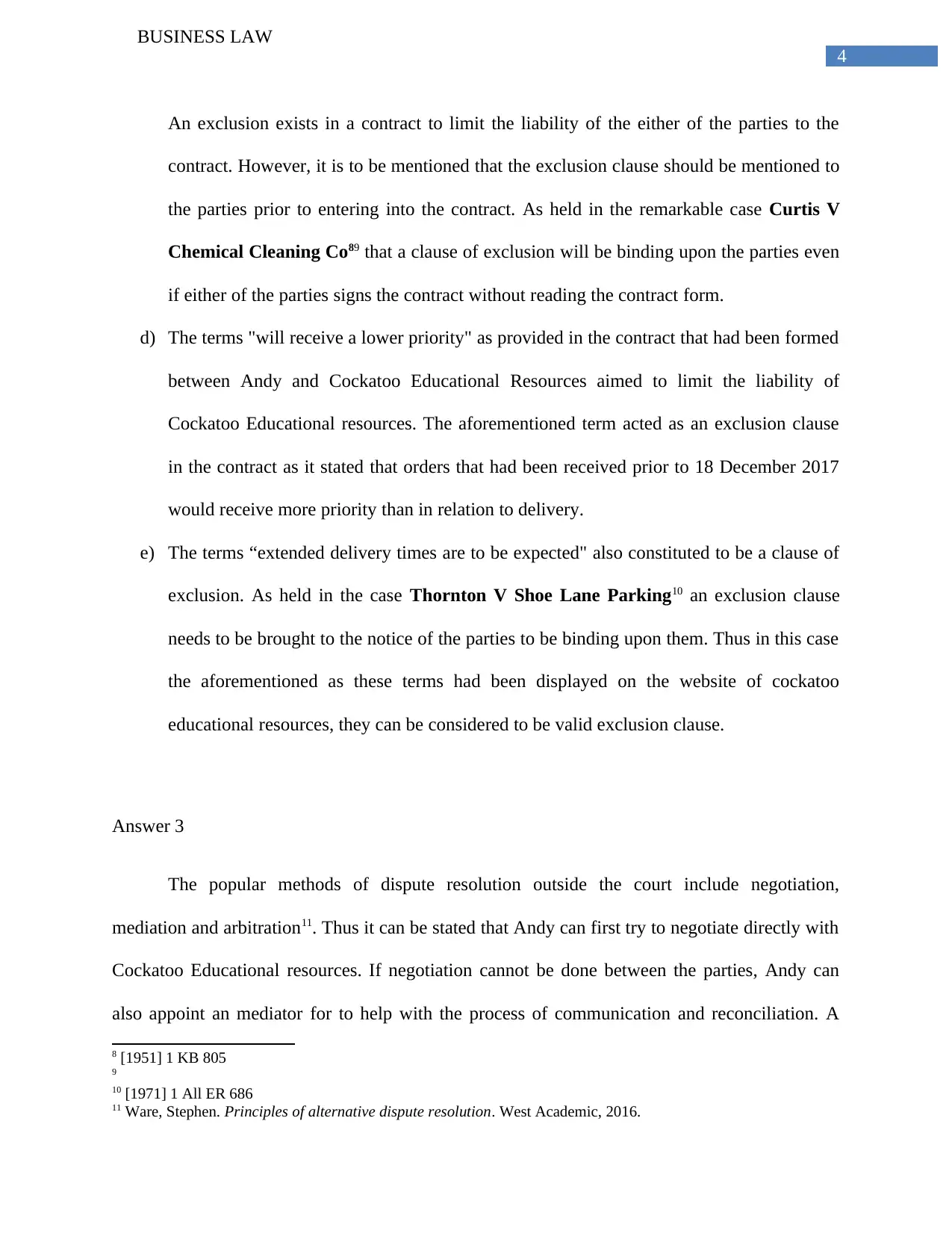
4
BUSINESS LAW
An exclusion exists in a contract to limit the liability of the either of the parties to the
contract. However, it is to be mentioned that the exclusion clause should be mentioned to
the parties prior to entering into the contract. As held in the remarkable case Curtis V
Chemical Cleaning Co89 that a clause of exclusion will be binding upon the parties even
if either of the parties signs the contract without reading the contract form.
d) The terms "will receive a lower priority" as provided in the contract that had been formed
between Andy and Cockatoo Educational Resources aimed to limit the liability of
Cockatoo Educational resources. The aforementioned term acted as an exclusion clause
in the contract as it stated that orders that had been received prior to 18 December 2017
would receive more priority than in relation to delivery.
e) The terms “extended delivery times are to be expected" also constituted to be a clause of
exclusion. As held in the case Thornton V Shoe Lane Parking10 an exclusion clause
needs to be brought to the notice of the parties to be binding upon them. Thus in this case
the aforementioned as these terms had been displayed on the website of cockatoo
educational resources, they can be considered to be valid exclusion clause.
Answer 3
The popular methods of dispute resolution outside the court include negotiation,
mediation and arbitration11. Thus it can be stated that Andy can first try to negotiate directly with
Cockatoo Educational resources. If negotiation cannot be done between the parties, Andy can
also appoint an mediator for to help with the process of communication and reconciliation. A
8 [1951] 1 KB 805
9
10 [1971] 1 All ER 686
11 Ware, Stephen. Principles of alternative dispute resolution. West Academic, 2016.
BUSINESS LAW
An exclusion exists in a contract to limit the liability of the either of the parties to the
contract. However, it is to be mentioned that the exclusion clause should be mentioned to
the parties prior to entering into the contract. As held in the remarkable case Curtis V
Chemical Cleaning Co89 that a clause of exclusion will be binding upon the parties even
if either of the parties signs the contract without reading the contract form.
d) The terms "will receive a lower priority" as provided in the contract that had been formed
between Andy and Cockatoo Educational Resources aimed to limit the liability of
Cockatoo Educational resources. The aforementioned term acted as an exclusion clause
in the contract as it stated that orders that had been received prior to 18 December 2017
would receive more priority than in relation to delivery.
e) The terms “extended delivery times are to be expected" also constituted to be a clause of
exclusion. As held in the case Thornton V Shoe Lane Parking10 an exclusion clause
needs to be brought to the notice of the parties to be binding upon them. Thus in this case
the aforementioned as these terms had been displayed on the website of cockatoo
educational resources, they can be considered to be valid exclusion clause.
Answer 3
The popular methods of dispute resolution outside the court include negotiation,
mediation and arbitration11. Thus it can be stated that Andy can first try to negotiate directly with
Cockatoo Educational resources. If negotiation cannot be done between the parties, Andy can
also appoint an mediator for to help with the process of communication and reconciliation. A
8 [1951] 1 KB 805
9
10 [1971] 1 All ER 686
11 Ware, Stephen. Principles of alternative dispute resolution. West Academic, 2016.
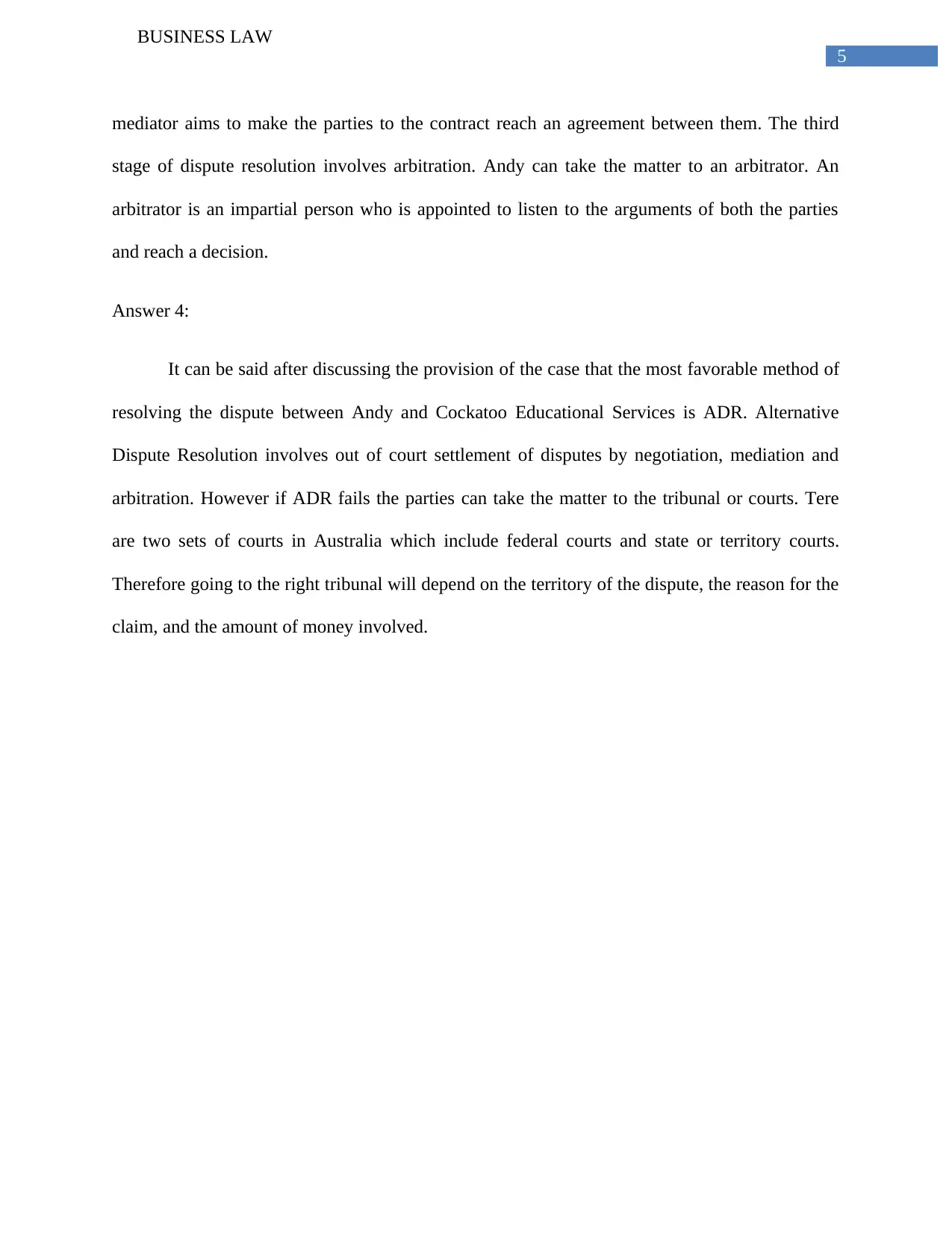
5
BUSINESS LAW
mediator aims to make the parties to the contract reach an agreement between them. The third
stage of dispute resolution involves arbitration. Andy can take the matter to an arbitrator. An
arbitrator is an impartial person who is appointed to listen to the arguments of both the parties
and reach a decision.
Answer 4:
It can be said after discussing the provision of the case that the most favorable method of
resolving the dispute between Andy and Cockatoo Educational Services is ADR. Alternative
Dispute Resolution involves out of court settlement of disputes by negotiation, mediation and
arbitration. However if ADR fails the parties can take the matter to the tribunal or courts. Tere
are two sets of courts in Australia which include federal courts and state or territory courts.
Therefore going to the right tribunal will depend on the territory of the dispute, the reason for the
claim, and the amount of money involved.
BUSINESS LAW
mediator aims to make the parties to the contract reach an agreement between them. The third
stage of dispute resolution involves arbitration. Andy can take the matter to an arbitrator. An
arbitrator is an impartial person who is appointed to listen to the arguments of both the parties
and reach a decision.
Answer 4:
It can be said after discussing the provision of the case that the most favorable method of
resolving the dispute between Andy and Cockatoo Educational Services is ADR. Alternative
Dispute Resolution involves out of court settlement of disputes by negotiation, mediation and
arbitration. However if ADR fails the parties can take the matter to the tribunal or courts. Tere
are two sets of courts in Australia which include federal courts and state or territory courts.
Therefore going to the right tribunal will depend on the territory of the dispute, the reason for the
claim, and the amount of money involved.
⊘ This is a preview!⊘
Do you want full access?
Subscribe today to unlock all pages.

Trusted by 1+ million students worldwide
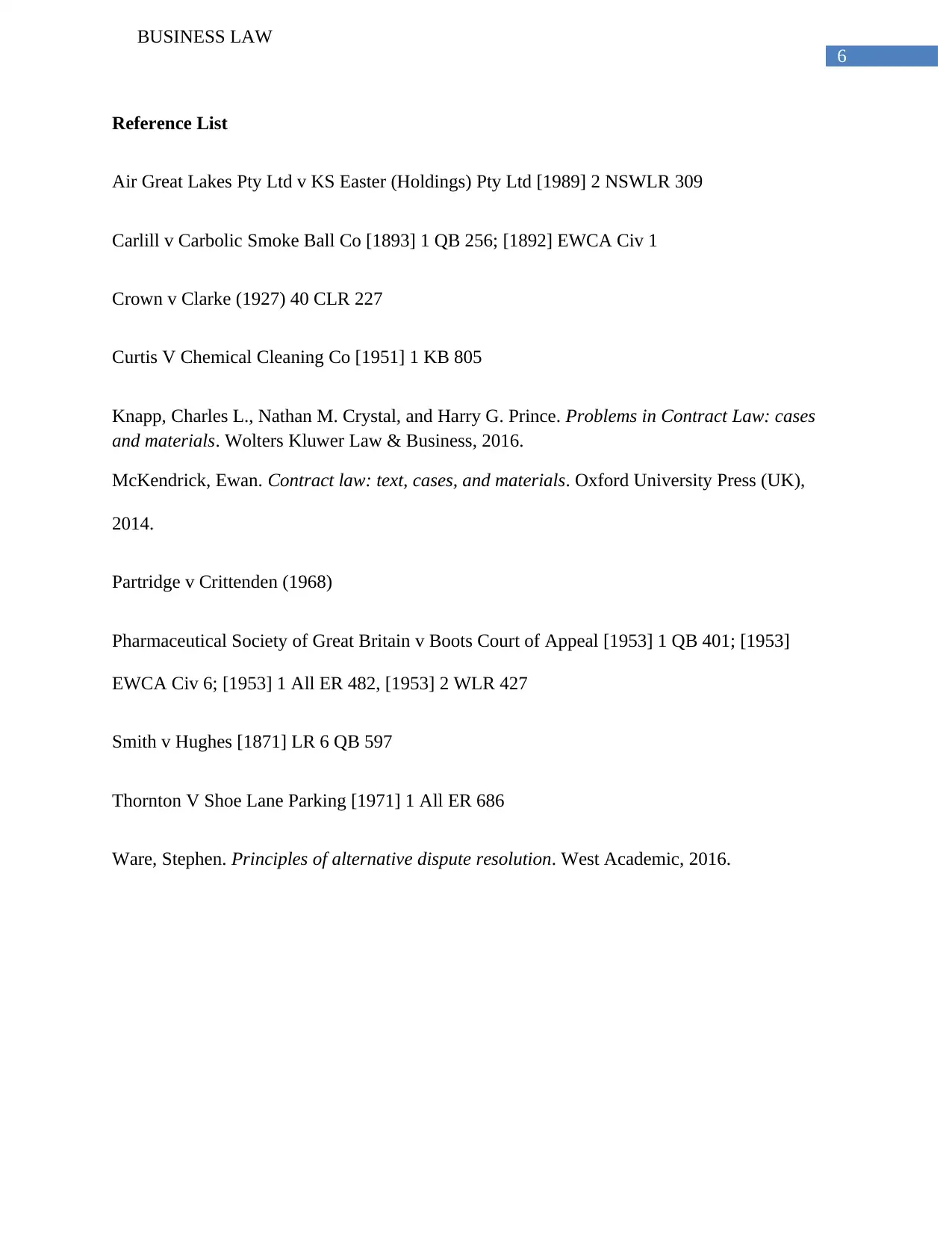
6
BUSINESS LAW
Reference List
Air Great Lakes Pty Ltd v KS Easter (Holdings) Pty Ltd [1989] 2 NSWLR 309
Carlill v Carbolic Smoke Ball Co [1893] 1 QB 256; [1892] EWCA Civ 1
Crown v Clarke (1927) 40 CLR 227
Curtis V Chemical Cleaning Co [1951] 1 KB 805
Knapp, Charles L., Nathan M. Crystal, and Harry G. Prince. Problems in Contract Law: cases
and materials. Wolters Kluwer Law & Business, 2016.
McKendrick, Ewan. Contract law: text, cases, and materials. Oxford University Press (UK),
2014.
Partridge v Crittenden (1968)
Pharmaceutical Society of Great Britain v Boots Court of Appeal [1953] 1 QB 401; [1953]
EWCA Civ 6; [1953] 1 All ER 482, [1953] 2 WLR 427
Smith v Hughes [1871] LR 6 QB 597
Thornton V Shoe Lane Parking [1971] 1 All ER 686
Ware, Stephen. Principles of alternative dispute resolution. West Academic, 2016.
BUSINESS LAW
Reference List
Air Great Lakes Pty Ltd v KS Easter (Holdings) Pty Ltd [1989] 2 NSWLR 309
Carlill v Carbolic Smoke Ball Co [1893] 1 QB 256; [1892] EWCA Civ 1
Crown v Clarke (1927) 40 CLR 227
Curtis V Chemical Cleaning Co [1951] 1 KB 805
Knapp, Charles L., Nathan M. Crystal, and Harry G. Prince. Problems in Contract Law: cases
and materials. Wolters Kluwer Law & Business, 2016.
McKendrick, Ewan. Contract law: text, cases, and materials. Oxford University Press (UK),
2014.
Partridge v Crittenden (1968)
Pharmaceutical Society of Great Britain v Boots Court of Appeal [1953] 1 QB 401; [1953]
EWCA Civ 6; [1953] 1 All ER 482, [1953] 2 WLR 427
Smith v Hughes [1871] LR 6 QB 597
Thornton V Shoe Lane Parking [1971] 1 All ER 686
Ware, Stephen. Principles of alternative dispute resolution. West Academic, 2016.
Paraphrase This Document
Need a fresh take? Get an instant paraphrase of this document with our AI Paraphraser

7
BUSINESS LAW
BUSINESS LAW
1 out of 8
Related Documents
Your All-in-One AI-Powered Toolkit for Academic Success.
+13062052269
info@desklib.com
Available 24*7 on WhatsApp / Email
![[object Object]](/_next/static/media/star-bottom.7253800d.svg)
Unlock your academic potential
Copyright © 2020–2025 A2Z Services. All Rights Reserved. Developed and managed by ZUCOL.




